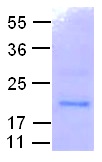Rab11 Protein
| 货号: 10126 |
| 产品名称: Rab11 Protein |
| 基因符号: Rab-protein 11, CG5771, DmRab11, Drab11, Rab-r11, RAB11 |
| Source: Human, recombinant full length, His6-tag |
| Expression 种属反应性: E. coli |
| Molecular Weight: 18 kDa |
| 纯化:: >95% by SDS-PAGE |
| Introduction: Rab11 is a small GTP-binding proteins of the Rab family, such as Rab11A, play essential roles in vesicle and granule targeting. Rab11 is also a GTPase that regulates endosomal trafficking to apical plasma membrane domains in polarized epithelial cells. |
| Amino Acid Sequence (1-173) |
MGTRDDEYDYLFKVVLIGDSGVGKSNLLSRFTRNEFNLESKSTIGVEFATRSIQVDGKTIKAQIWDT
AGQERYRAITSAYYRGAVGALLVYDIAKHLTYENVERWLKELRDHADSNIVIMLVGNKSDLRHLRAV
PTDEARAFAEKNGLSFIETSALDSTNVEAAFQTILTEIY |
Properties
|
| Physical Appearance (form): Dissolved in 20mM Tris-HCl, pH8.0, 150mM NaCl. |
| Physical Appearance (form): White or clear |
| 浓度: 1 mg/mL |
| Storage: -80°C |
Preparation Instructions:
Centrifuge the vial before open the cap and reconstitute in water. Adding of 10 mM β-mercaptoethanol or 1 mM DTT into the solution to protect the protein is recommended and using of non-ionic detergents such as n-Dodecyl β-D-maltoside (DoDM) or polyethylene detergents (e.g. C12E10) also help to stabilize the protein. Avoid repeated freezing and thawing after reconstitution. The purity of His-tagged Rab11 was determined by SDS- PAGE and Coomassie Brilliant Blue Staining. |

References:
1. Bao, X. et al., Europ. J. Biochem. 269: 259-271, 2002.
2. Gromov, P. S. et al., FEBS Lett. 429: 359-364, 1998.
3. Casanova, J. E. et al., Molec. Biol. Cell 10: 47-61, 1999.
4. Drivas, G. T. et al., Oncogene 6: 3-9, 1991.
5. Gromov, P. S. et al., FEBS Lett. 429: 359-364, 1998.
6. Guichard, A. et al., Nature 467: 854-858, 2010.
7. Larance, M. et al., J. Biol. Chem. 280: 37803-37813, 2005.
8. Shirane, M. et al., Science 314: 818-821, 2006.











